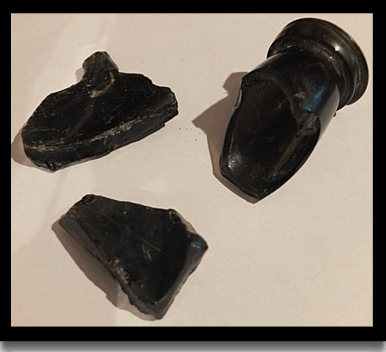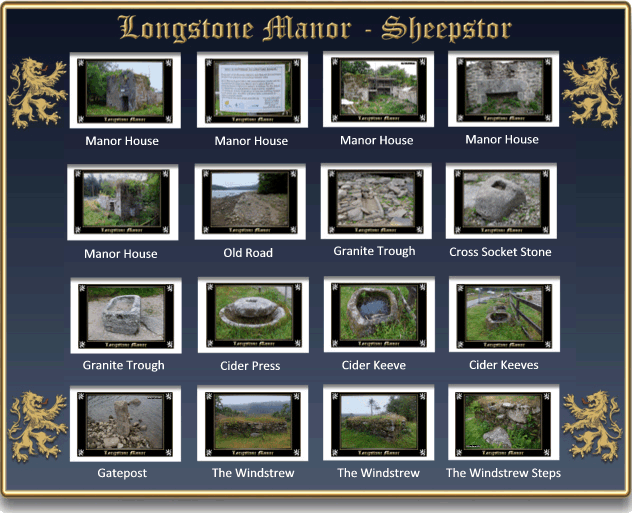
“The authors of the Magna Britannia state that the manor “belonged in the reign of Henry III. to a family of Herbert Combe, who were succeeded by Scudamore. A co-heiress of Scudamore, about the end of the 15th century, brought it to the Elfords, in which family it continued until after the death of the last heir male of the elder branch in 1748. It is now the property of Walter Northmore, Esq. Longstone the ancient residence of the Elford family, is now a farmhouse.“, – Lysons, p.489
As can be seen above, there is a suggestion that the earliest dwelling on the site of Longstone Manor dates back to the thirteenth century and was built by Herbert de Cumba who was Lord of the Manor of nearby Sheepstor, however this has not been substantiated. Having said that, recent archaeological investigations have found evidence of medieval pottery on the site.
But by the very place-name – ‘Longstone‘ there is a possibility that something much earlier stood at or near the location. The term ‘Longstone‘ can in some cases refer to a Bronze Age standing stone or menhir which could suggest the one-time presence of one?.
Longstone came into the possession of the Elford family when John Elford married Johanna Scudamore in the 15th Century as alluded to by Lysons.
Much of what stands today is a result of the building work carried out by Walter Elford and his wife Barbara in 1633. In support of this at Wembley Walk there is an inscribed stone taken from Longstone which carries the inscription – 1633 WEB which was removed from Longstone. The main two storey structure was built using granite rubble-stone walls with killas infill along with granite ashlar on the south wall. Its dimensions are 14.5 metres long by 6.5 metres wide and stands at over four metres tall. Today there is evidence of five windows and three fireplaces The original entrance to the dwelling was through a south facing, two storey porch containing a four-centred arched entrance along with one window opening above and two others on either side of the bay.
Just to go slightly off track for the moment, John Elford was (according to some writers) a known supporter of the Parliamentarian faction during the English Civil War, although other versions give it that he was a Royalist supporter. Either way he somehow he managed to get on the wrong side of Cromwell and became embroiled in a plot against the Lord Protector. This came to the attention of Cromwell who sent some troops to arrest Elford. Luckily he got a tip off that they were coming and fled up to the Piskies Cave on nearby Sheepstor where he took refuge.
Dotted around the house are some relics from the granite age which include various troughs, a slotted gate post, a cider press, some of which were removed from neighbouring farms in the 1920s.
Probably the star of the show has to be the large granite platform known as a windstrew which lies seventy metres to the north-west of the main building. The purpose of this structure was to enable threshers to flail the corn and then winnow the chaff with the assistance of the wind. It measures and impressive 6 metres long by 5.5 metres wide and stands 1.3 metres tall with a block of 3 steps on the south eastern side. There is every chance that this was built in 1637 at the instructions of John and Anna Elford. Again, a stone now residing in Wembley Walk is inscribed IE AE 1637 (John Elford 1637 Anna Elford) and is said to have originated from the windstrew.
According to English Heritage this windstrew is the only surviving example of its kind in the whole of England such is its importance. However, Eric Hemery describes a similar platform at Reddaford Farm; “adjacent to the farmhouse is a rectangular platform, thirty feet by ten… the platform was almost certainly a windstrew.”, p.989.
In 1898 this feature was referred to as a ‘windstone‘ in the Fifteenth Report of the Committee of Devonshire Folklore. Transactions of the Devonshire Association, p.90. Another name that has appeared for the windstrew is the ‘Hebrew Threshing Floor‘ and apparently came from George Shillibeer in 1866, the last tenant of Longstone. In the Devon and Cornwall Notes and Queries of 1918/19 the following appeared: “Mr. G. Shillibeer, the bailiff of the corporation, also states that the name of “Hebrew Threshing Floor” is the name of the granite platform paved, not with cobble stones, but granite...”. Apparently with a ‘Hebrew Threshing Floor, the piece goes on: “The sheaves were put on cloths on the ground, the ox walked round and trod out the corn. It was then thrown on to the granite platform and the wind carried away the chaff.”, p.92. It appears that this notion came from the fact that such a thing was illustrated in a children’s religious picture book of the time and supposedly struck a chord of similarity with Shillibeer to the windstrew?
Just to go slightly off track for the moment, John Elford was a known supporter of the Parliamentarians although other writers state he was a Royalist during the English Civil War. Either way, he somehow he managed to get on the wrong side of Cromwell and became embroiled in a plot against the Lord Protector. This came to the attention of Cromwell who sent some troops to arrest Elford. Luckily he got a tip off that they were coming and fled up to the Piskies Cave on nearby Sheepstor where he took refuge.
John Elford was noted for his artistic eye and designed several memorials, two of which can be seen in nearby Sheepstor church, one was to his wife and children and the other a magnificent sundial dated to 1640
In 1748 John, the last of the Longstone Elfords died, he was married to Admonition Prideaux and passed away without any surviving heirs, he six children sadly predeceased him, Baring Gould, p.221. Following John’s death the property came into the possession of Sir Massey Lopes. He promptly removed an attached west wing and the courtyard. He also blocked the windows and replaced them with sashes. The manor along with its lands was then tenanted up until 1898 when the last tenant, George Shillibeer was given notice to quit prior to the construction of Burrator Reservoir.
The last surviving member of the Elford family was William Elford of Bickham, he was the recorder of Plymouth and died in 1837 thus ending the baronetcy of the Elford family, Burke, p.600.
Many of the ancillary buildings are now lost under the depths of Burrator Reservoir along with much of the trackway which ran from the manor to the village of Sheepstor. Having said that a 39 metre stretch of cobbled sunken trackway can be seen running 90º to the main house.
In the late 1920s a fragment of a wine flagon was discovered on the edge of the reservoir on it was the Elford crest, Hemery, p.118 fn, and to this day it is possible to find fragments of old glass bottles dating way back.

In 1999 an archaeological survey was carried out on both the building and some associated structures which lay below the waterline. To the west of the house a midden was discovered which produced finds that included tiles and post-medieval pottery sherds. Beneath the water further finds of post-medieval pottery were found along with some earlier medieval examples. Additionally some earlier re-used masonry was found in the house and a fragment of a medieval arch was located embedded in the wall of the sunken trackway. Such finds would confirm the fact that at one time there was earlier occupation of the manor site.

It is envisaged that the consolidation work will be finished by September when the scaffolding will be taken down and it will be possible to see the manor house in its full glory, or what’s left of it that is.

Baring Gould, S. 1982. A Book of Dartmoor. London: Wild Wood House Ltd.
Burke, J & Bernard-Burke, J. 1838. The Extinct and Dormant Baronetcies of England. London: Scott Webster and Geary.
Hemery, E. 1983. High Dartmoor. London: Robert Hale and Co.
Lysons, D, 1822. Magna Britannia. London: Thomas Cadell.
 Legendary Dartmoor The many aspects past and present of Dartmoor
Legendary Dartmoor The many aspects past and present of Dartmoor
